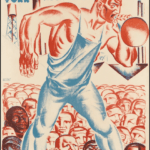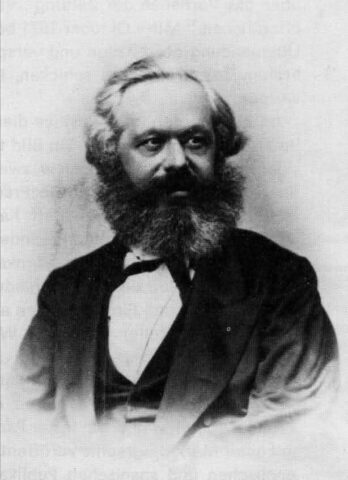
Culture is a fundamental field of battle in the necessary transformation, without which revolutions are impossible, of the working class from a ‘class in itself’ to a ‘class for itself’. ‘Artistic’ vehicles like film dominate the presentation of dominant ideas today. Previously, it was theater. Moissaye Olgin looks at the state of artistic production and presents these seven theses for the establishment of a workers’ theater in the U.S.
‘For a Workers’ Theatre’ by Moissaye Olgin from the Daily Worker Saturday Supplement. Vol. 4 No. 68 & 74. April 2 & 9, 1927.
“Why necessarily a workers’ theatre? Why not a better theatre for all?”
The question has been raised wherever the theatre came up for discussion in so-called radical intellectual circles. The theatre as it exists is such a mockery at life’s truth, art and human intelligence, that to demand the creation of a special class theatre seems an uncalled for and therefore damaging division of forces. An adequate answer to this superficially convincing objection would involve an analysis of the class-psychology expressing the class position in society of the various factors to the process of wealth creation. While this may be a thankful task in itself–since the work of drawing the line of demarkation between the social classes in the realm of self-expression has hardly begun in the United States–the approach to the theatre question may be purely practical. The workingman does not go to the existing theatre. The most advanced and class-conscious workers who, in their cultural hunger, sometimes invade the private commercial theatre, are thoroughly disgusted with its fare, but then they are a very small fraction of the working class. The mass of workers goes to cheap vaudeville houses or to the cinema, but they are dead to the call of the “legitimate stage!” The question reduces itself to this: Is it possible to create in a large industrial center a theatre which, while gratifying the thinking elements of the mill and shop, would irresistibly draw the rank and file of the working class, thus opening before them a world of new experiences?
We answer the question in the affirmative (“we” embraces here a group of educators doing cultural work among the masses). We proceed from the assumption that while the advanced workers despise the existing theatre for its commercialism, its mawkish pseudo-realism, its standardization, as well as for the lack of a content bearing significance for the working class spectator, the bulk of the workers. disregard the theatre because they do not find in it anything of interest for themselves. To educate the working masses in the enjoyment of theatrical art is to give them a theatre in which they will find things attractive, absorbing, stirring, vital from their standpoint.
It is too easy to rest on the lazy assertion that the working masses have not yet grown to respond to theatrical art. As a matter of fact, there isn’t a mass in the world that is incapable of enjoying theatrical art. The enjoyment of the theatre is widespread and primitive. The basic demand for it is universal. This demand is at present being satisfied by substitutes either poisonous or silly. We propose that a theatre be created which, applying art means, would find a way to the inmost soul of the working masses.
We do not blame the average worker for not heeding the theatres that exist. Of course, we are fully aware of the existence of “good” plays: those of Shakespeare for instance, once in a while, or those of Shaw, or some other “highbrow” author. But aside from the fact that a man of the masses cannot thrive long on such “heavy” menu (can we?) one must not forget that such performances are only oases in the midst of a vast theatrical desert all full of the sands of little incidents in the life of the propertied classes, presented in a polished conventionalized fashion for the after-dinner entertainment of the same propertied classes, or strewn with the bones of “high” tragedy mostly of an unreal and therefore unconvincing nature. Why should the structural iron workers be interested in the fact that a society lady is craving for a male friend to drink tea with while her husband is in his business office? Why should the bricklayer shed tears over the fate of a great bootlegger and master burglar losing both his fortune and the aristocratic girl he loves? What share can my neighbor, Jack the locksmith, have in the plight of the duchess who is wearing a paste diadem while her genuine jewels are in the pawn-shop? What have my friends, the cloak, suit and skirtmakers, to do with this idle, empty, sated and unimaginative world of tailored gentlemen and perfumed ladies whose lives pass in peanut emotions and flat pleasures.
Now, my neighbor Jack is by no means stupid. He is an alert fellow of about thirty-eight. He is a union member of long standing and loves to tell about strikes of former years. He has an instinctive dislike for the “boss,” the “trust” and the “politician,” though you would not class him among the conscious workers. He is of a rather mocking bent of mind, and when one of the female middle- class inhabitants of the neighborhood passes by his shop window, he puckers his face into a malicious grimace. He is not a reader of books or papers, but he loves to talk to his shop mates, and is of a highly companionable nature. He is keen on “stories,” “yarns,” adventure, and this is what draws him to the “movies,” which he has sense enough to consider of no importance. Can we not draw this Jack and a hundred thousand other Jacks and Maries and Sadies, more or less advanced, into a theatre which would both hold their attention and elevate them to a higher plane of mental life?
All depends upon what the theatre would offer:
1. The first prerequisite is a theatre pulsating with the realities of life surrounding the worker, a theatre bold enough to look America in the face. It is characteristic of bourgeois art to shun cruel and crude realities, to gloss over conflicts.
The theatre as it exists is therefore worlds apart from the robust colorful countenance of life. The theatre is the shadow of a ghost either of emotion or adventure. A workers’ theatre must throb with the full and deep heartbeat of the world we live in, the country we are building, the historic epoch we are traversing.
Lazy objection will say: “Ah, you want a theatre of propaganda.” We will reply with Lunacharsky: “God save us from a play which is a strike bulletin in five acts.” We do not want a theatre which makes direct propaganda for this or that “cause.” We do want a theatre that will make the worker a broader and more humane man and thereby enable him to be a better member of his class. We do not want propaganda, but we do not want shutting out everything that is not “love” or “sex appeal” among the bourgeoisie or its intellectual adjunct. We want to see a world which also includes the working masses, a world in which Gary, Ind., Lawrence, Mass., and Passaic, N.J., will take their legitimate place. We want a theatre that will discover America, its present big industrial heart, its rural toilers all over the land, its grandiose past (Westward! discovering and conquering a continent:) back to its origins in a dramatic, revolutionary mass upheaval. We wish America portrayed in a new theatre–America, beautiful and hideous, sweating and seeing visions, mean and full of enormous spiritual possibilities and we want the toiler to occupy in that America the place that is his in the scheme of things.
2. A second prerequisite is to present all this in a manner that will be comprehensible to the masses. The bourgeois theatre does not know simplicity. The bourgeois theatre is making up in elaborate phraseology what it misses in contents. The workers’ theatre must proceed from the assumption that there is nothing in the life of human beings that cannot be made accessible to the We do not propose to sacrifice art to popularity. We propose to return art to the dignity of simplicity and truth. By giving to the masses such pieces as dwell upon things close to the heart of the masses, and by remaining truly artistic, i.e., finding a form adequate to the material, we can attract hundreds of thousands, nay, millions, who at present feed on atrocious trash.
The question of the playwright for this new kind of drama presents the least difficulty, inasmuch as the theatre actually molds the dramatist, and the economic law of supply and demand is particularly applicable to the theatre realm, where there is an overproduction of playwrights. Given an actual demand, the new play will soon make its appearance.
3. By no means do we wish a gloomy theatre, or a solemn theatre, or a morbid theatre, or a high-falutin theatre. What we wish is a theatre where the typically bourgeois subject of individual, mainly sexual, “love” sufferings, conflicts and problems is relegated to the rear, if not entirely abandoned, while the wider aspects of life-social, economic, political, cultural-including the emotions of men and women, not sugar-coated but real and convincing in their truth–occupy the front. We do not wish a theatre that preaches. We detest moralizing pieces. But similarly we detest empty, senseless pieces, anecdotes in three acts with lingerie and interior decoration. We wish to see things that are full of significance, strong, vital, vibrant, stirring, not only showing the tragic face of life, but also ready to laugh, to mock, to ridicule, to construe a grotesque image, to grip the soul with a sun-lit vision. We wish a theatre that lives a full-chested life instead of talking polite words in a drawing room or in a country club. We wish to see both suffering and joy, injustice and struggle, sweeping passions and life-giving ideas, wisdom and mirth, blackness and rainbow-spanned horizons, childishness and manhood, love and sacrifice, victors and vanquished-all this not in the abstract, but incarnated in people, appearing in the actions of living men and women.
4. It is obvious that a theatre of this kind will depart in its methods from the purely “speaking” theatre with painted scenery. It will certainly be a constructivist theatre, employing all elements that go into the formation of theatrical art: drama, music, plastic motion, sculpture, painting, lighting. While it is impossible and hardly desirable to lay down a rule as to what kind of production we would like to see in the workers’ theatre, it is safe to say, negatively, that such theatre will not imitate life, mimic or photograph life, that it will not confine itself to pretty sterilities or cut and dried polite mannerisms–positively, that it will be a creative theatre constructing for each piece its own forms of expression, searching for new means, ever groping, never resting on its laurels (the pre-Revolutionary Moscow Art Theatre was of this kind, though serving the needs of the Russian bourgeois intelligentzia under Tzardom).
The workers’ theatre must be an embodiment of the modern forms of production enlivened and invigorated by fresh storm-swept material taken from the very heart of the present cataclysmic era. It needs not much proving that a theatre showing the sky-scraper and the blast furnace, the laboratory and the picket line, the naval monster and the grain elevator, the plantation Negro and the Kentuckian mountaineer, the railroad strike and the war of lethal gasses, will not be able to confine itself to the methods of production of “The Great Gatsby,” “Bride of the Lamb,” Craig’s Wife,” or even “Desire Under the Elms” or “The Great God Brown.” It must, however, be made a conscious task–to work collectively for new forms and new methods of presentation.
5. This brings up the question of a staff. We picture the workers’ theatre as consisting of a coterie of actors, painters, sculptors, dancers, playwrights, musicians, lighting masters, all having contact with the masses, at least sympathetic to labor’s struggle, some of them hailing from the ranks of labor, all of them working in cooperation for the creation of significant beauty, all animated with the striving for the higher art which is of necessity more human and more true than the commercial mummery or even the better “little theatre,” which, after all, is a child of the more enlightened and artistically sensitive bourgeoisie. It is to be assumed that the formation of such a group of theatrical conspirators against the existing order will be a dialectical process. Obviously, it will include a majority of younger men and women. Possibly, many an artist will only begin his career in the workers’ theatre. Undoubtedly, the theatre will draw its main vital power from the solid mass of workers.
What we wish to see is a theatre where the reverse of politeness is the rule. In a theatre without polite plays, where this very politeness of the “better society” is perhaps held up to ridicule, one cannot expect the participants to be moving and conversing like the drawing room mannikins we see in the bourgeois theatre. We picture a theatre full of action, motion, broad gestures, high intonations, clashes of light, reverberations of sounds, colorful groupings, words enhanced by music, music deepened by stirring light effects, light made a part of the whole performance. We wish to see a theatre where not only the truth is released through real artistic construction, but where the actor-in the broader sense of the word-is released to greater freedom of expression.
5. This theatre will have meaning, only when it removes the barrier between the stage and the audience. Many an attempt was made to achieve this (Reinhardt placing the stage in the center of and on a lower level than the audience, Meyerhold making some of the actors stand up in the middle of the audience and delivering a speech as if they were part of it, American producers sending out their performers into the aisles, etc.) but all these were mechanical means. To remove the barrier between stage and spectators means to create such an intimate understanding and community om emotion between performers and audience that the latter cease to be mere spectators. It must be admit- ted that the present writer never saw in the legitimate American theatre that abandon on the part of the spectators, that restless absorption in the proceedings on the stage, that hanging on every word of the players that he often found in dramatic clubs performing “for their own people.” A workers’ theatre must be a band (gang?) of men and women known to the working masses as “our own” and performing in such a spirit of mutual understanding between themselves and the workers as would render the theatre one emotional whole. Such closeness cannot be created artificially. It must be the outcome of the workers having recognized the players as part of their lives and having taken them to their bosom. While this mutual understanding must come not only from the making of art but from gaining recognition in ways other than art creations, it will enhance the pure art enjoyment of the audience immensely.
6. The theatre, groping for ever new ways, must necessarily be combined with one or several theatre studios where new players are being attracted to the work and new methods are being tested. We picture the studios as a connecting link between the theatre and the working masses, or rather as ramifications of the theatre reaching out into the masses. We picture hundreds of young working men and working women passing through these studios, acquiring the technique of theatrical self-expression, forming, as it were, the theatrical vanguard of the working masses (theoretically that vanguard can be increased to embrace a very large section of the class-conscious elements of the workers) spreading among them theatrical culture. From another angle the same vanguard may be looked upon as theatrical reserves to be drawn for the performance of mass plays which must be one of the main features of a workers’ theatre, and for expanding the theatre in times of need.
The bourgeois theatre is being utilized for imperialist and chauvinist ends (war propaganda, Red Cross drives, etc.), the workers’ theatre must be an instrument of the workers in that it actively participates in their class struggle. We imagine a detachment of the New York Workers’ Theatre going out to Passaic to perform, in a hall or in the open air, for the textile strikers–not only to raise funds, but, mainly, to hearten the strikers and their children. We imagine a devil-may-care troop of young theatrical “frontiersmen” rushing out of Chicago to Herrin, Ill., and to other coal-mining towns to form the great theatrical event of the coal strike. We imagine workers’ theatre artists decorating labor’s convention halls and giving performances for the delegates. That such performances cannot, by the nature of things, be polite, that they must assume a sarcastic, anti-capitalist nature, will by no means lessen the value of the theatre in the eyes of the working class. We are against propaganda as marring the artistic quality of a vital performance. But welcome propaganda, i.e., directing thoughts and emotions in a definite channel, once it comes as a result of an artistic performance. By so participating in the everyday life of the workers, the workers’ theatre will gain that intimate connection with the workers which will make them rush to every new performance and watch the players with enthusiasm and adoration–provided the performances in themselves are worth seeing.
Pageants and performances for workmen’s children must be a part of the program of a workers’ theatre.
7. The theatre must be a public undertaking financed either by labor unions or by the sale of shares among the workers (details of organization need not be here entered into) and making no profit. Its staff must consist of a nucleus of professionals with a large auxiliary force of theatrically skilled and semi-skilled workers. It must be a repertory theatre with no stars. It must be a pre- dominantly American theatre, admitting, however, exceptionally good foreign plays.
Is this a dream? It depends on the initiative of a few. There is an enormous potential audience; there are many intellectuals, who, being friendly to labor and disgusted with the bourgeois theatre, are aching to put their energy to the creation of something new and useful both for art and the workers. There are young actors and other artists ready to attempt the experience of collective work for a collective art. There are tokens in the air pointing the way: workers’ art clubs, singing societies, dramatic circles, etc., mostly among foreign-born workers, who, of late, however, have grown to know English and will certainly welcome a workers’ theatre in English.
There must be a crystallizing point to set the movement afoot. The aim of this article is to point out this need, and, perhaps, hasten the formation of such a point.
“Are you preaching proletarian art?” we hear disquieted questions. Our answer is: Let names alone. Let us do the thing. When it will have materialized and gone part of its road of development, we will have time enough to discuss where to class it.
The Daily Worker began in 1924 and was published in New York City by the Communist Party US and its predecessor organizations. Among the most long-lasting and important left publications in US history, it had a circulation of 35,000 at its peak. The Daily Worker came from The Ohio Socialist, published by the Left Wing-dominated Socialist Party of Ohio in Cleveland from 1917 to November 1919, when it became became The Toiler, paper of the Communist Labor Party. In December 1921 the above-ground Workers Party of America merged the Toiler with the paper Workers Council to found The Worker, which became The Daily Worker beginning January 13, 1924.
PDF of full issue 1: https://www.marxists.org/history/usa/pubs/dailyworker/1927/1927-ny/v04-n068-new-magazine-apr-02-1927-DW-LOC.pdf
PDF of full issue 2: https://www.marxists.org/history/usa/pubs/dailyworker/1927/1927-ny/v04-n074-new-magazine-apr-09-1927-DW-LOC.pdf
Source by https://revolutionsnewsstand.com
![]()




